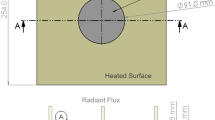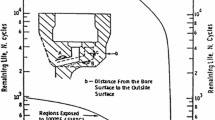Abstract
Advanced aerospace structures are often subjected to combined thermal and mechanical loads. The fracture-mechanics behavior of these structures may be altered by the thermal state existing around the crack. Hence, design of critical structural elements requires the knowledge of stress-intensity factors under both thermal and mechanical loads. This paper describes the development of an experimental technique to verity the thermal-stress-intensity factor generated by a temperature gradient around the crack. Thin plate specimens of a model material (AISI-SAE 1095 steel) were used for the heart transfer and thermal-mechanical fracture tests. Rapid thermal loading was achieved using high-intensity focussed infrared spot heaters. These heaters were also used to generate controlled temperature rates for heat-transfer vertification tests. The experimental results indicate that thermal loads can generate stress-intensity factors large enough to induce crack growth. The proposed thermal-stress-intensity factors appear to have the same effect as the conventional mechanical-stress-intensity factors with respect to fracture.
Similar content being viewed by others
References
Emery, A.F., Walker, G.E. andWilliams, J.A., “A Greens Function for the Stress Intensity Factors of the Edge Cracks and Its Application to Thermal Stresses,”Trans. ASME, J. Basic Eng.,91,618 (1969).
Zhang, P. andBurger, C.P., “Transient Thermal Stress Intensity Factors for Short Edge Cracks with Equal Depth of Crack Tips,”Eng. Fract. Mech.,24 (4),589–599 (1986).
Kokini, K. andLong, M.A., “Transient and Thermal Fracture of Cracked Plates,”Experimental Mechanics,28 (4),373–381 (Dec. 1988).
Yagawa, G., Ichimiya, M. and Ando, Y., “Theoretical and Experimental Analysis of Semi-Elliptical Surface Cracks Subject to Thermal Shock,” Fracture Mechanics, ASTM STP 677, ed. C.W. Smith, Amer. Soc. for Test. and Mat., 381–398 (1979).
Nied, H.F., “Thermal Shock in an Edge Cracked Plate Subjected to Uniform Surface Heating,”Eng. Fract. Mech.,26 (2),239–246 (1987).
Kuo, A.Y., Riccardella, P. andGallagher, J.P., “Stress Intensity Factors for Cracking Metal Structures under Rapid Thermal Loading,”AFWAL-TR-87-3022, Flight Dynamics Directorate, Wright Laboratory, Wright-Patterson Air Force Base, OH (June 1987).
Kuo, A.Y. and John, R., “Analytical and Experimental Treatment of a Single Edge Cracked Plate Subjected to Arbitrary Point Heat Sources,” 22nd Nat. Symp. on Fract. Mech., ASTM STP 1131, Amer. Soc. for Test. and Mat., Philadelphia, PA, to be published in 1992.
Bueckner, H.F., “Field Singularities and Related Integral Representation,”Methods of Analysis and Solutions of Crack Problems, Vol. I, ed. G.C. Sih, Noordhoff Publishers, Holland, 239–314 (1973).
Tada, H., Paris, R. andIrwin, G., The Stress Analysis of Cracks Handbook, Del Research Corporation, PA (1973).
Kuo, A.Y., Riccardella, P.C., Tang, S.C., Corney, C.S., John, R., Hartman, G., Gallagher, J.P. andKroupa, J.L., “Stress Intensity Factors For Cracking Metal Structures Under Rapid Thermal Loading,”WRDC-TR-89-3074, Final Rep.,II,Flight Dynamics Directorate,Wright Lab. Wright-Patterson AFB,OH (Aug. 1989).
John, R., Hartman, G.A., Gallagher, J.P. andKroupa, J.L., “Thermal Loading Induced Stress Intensity Factors for Cracking Metal Structures,”UDR-TR-89-39, Univ. of Dayton Research Inst., Dayton, OH (April 1989).
Hartman, G.A. andAshbaugh, N.E., “A Fracture Mechanics Test Automation System for a Basic Research Laboratory,”The Application of Automation Technology to Fatigue and Fracture Testing, ASTM STP 1092, ed. A. Braun, F. Smith andN. Ashbaugh, Amer. Soc. for Test. and Mat., Philadelphia, 95–110 (1990).
Author information
Authors and Affiliations
Rights and permissions
About this article
Cite this article
John, R., Hartman, G.A. & Gallagher, J.P. Crack growth induced by thermal-mechanical loading. Experimental Mechanics 32, 102–108 (1992). https://doi.org/10.1007/BF02324720
Received:
Revised:
Issue Date:
DOI: https://doi.org/10.1007/BF02324720




